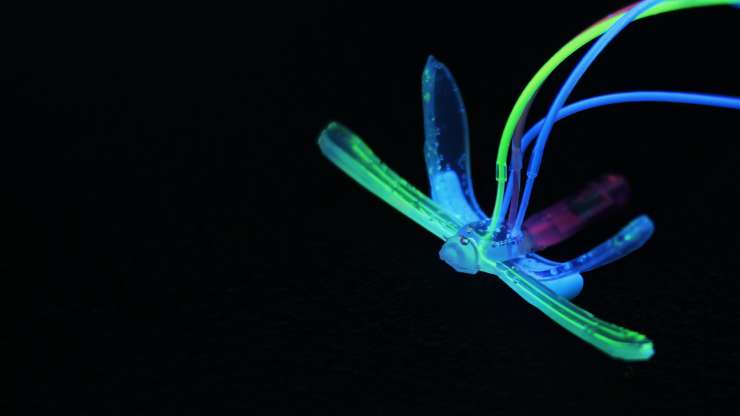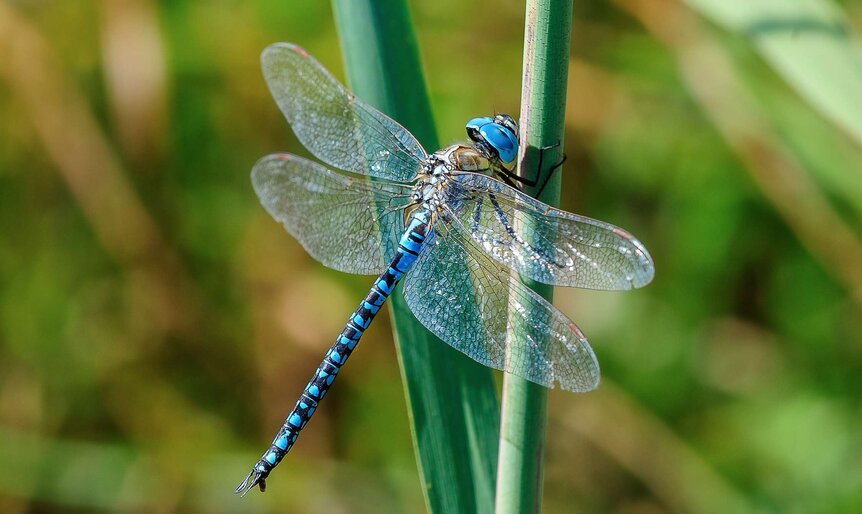Create a free profile to get unlimited access to exclusive videos, sweepstakes, and more!
This tiny, robotic dragonfly flies around to detect and clean up oil spills

Borrowing yet again from the ingenious design of Mother Nature, scientists at Duke University have created an elegant robotic dragonfly to help detect and diffuse environmental hazards around the globe.
Duke engineers designed this electronics-free soft robot to hover and skim across bodies of water where it's programmed to monitor changing conditions like pH, temperature or the presence of oil.
In a new proof-of-principle study published online in the scientific journal Advanced Intelligent Systems, researchers explained the dynamics and functions of what they've named DraBot and detailed how it might be the progenitor of more autonomous, long-range sensors for keeping tabs on problematic eco-issues.
This flexible artificial dragonfly was the brainchild of Shyni Varghese, professor of biomedical engineering, mechanical engineering and materials science, and orthopaedic surgery at Duke University.
“I got an email from Shyni from the airport saying she had an idea for a soft robot that uses a self-healing hydrogel that her group has invented in the past to react and move autonomously,” said lead study author Vardhman Kumar, a PhD student in Varghese’s laboratory. “But that was the extent of the email, and I didn’t hear from her again for days. So the idea sort of sat in limbo for a little while until I had enough free time to pursue it, and Shyni said to go for it.”
Varghese’s rough idea paired her team's self-healing hydrogel that responds to pH changes with a soft robot that could zoom across water and discover spots where pH changes are present. Aided by Ung Hyun Ko, a Duke postdoctoral fellow and colleague, Kumar first crafted a soft robot based on a housefly, then developed it into a dragonfly-shaped robot engineered with interior microchannels that allow it to be manipulated using air pressure.
DraBot's body measures approximately 2.25 inches long with a 1.4-inch wingspan and was born by pouring silicon into an aluminum mold and then baking it. Soft lithography enabled the team to design its interior channels connected with flexible silicon tubing.
“Getting DraBot to respond to air pressure controls over long distances using only self-actuators without any electronics was difficult,” said Ko. “That was definitely the most challenging part.”
DraBot's flight capabilities arrive via air pressure coming into its wings, where microchannels deliver air into the front wings, where it escapes through holes pointed directly into the back wings.
When both back wings are in the down position, airflow is blocked. If both wings are up, DraBot drifts forward. Balloon actuators under the back wings near DraBot’s body make the wings curl upward or downward, allowing scientists to control DraBot's direction.
“We were happy when we were able to control DraBot, but it’s based on living things,” explained Kumar. “And living things don’t just move around on their own, they react to their environment.”
By painting one set of wings with self-healing hydrogel, Kumar and his crew made DraBot react to changes in the surrounding water’s pH. According to Duke's press release, "As the water becomes acidic, one side’s front wing fuses with the back wing. Instead of traveling in a straight line as instructed, the imbalance causes the robot to spin in a circle. Once the pH returns to a normal level, the hydrogel “un-heals,” the fused wings separate, and DraBot once again becomes fully responsive to commands."
To enhance its environmental activism, the engineers positioned sponges beneath the wings and smeared them with a temperature-responsive coating. As DraBot travels over water with visible surface oil, the sponges soak it up and change color to the corresponding hue of oil. When waters become unusually warm, DraBot’s wings alternate from red to yellow.
Researchers believe the skill to soak up oils makes these long-distance skimming robots the perfect choice for early detection of dangerous oil spills. Color fluctuations caused by temperatures changes might detect indications of red tide and the harmful bleaching of coral reefs.
Duke's team is already entertaining ideas on how this DraBot prototype can be improved upon using wireless cameras, solid-state sensors, or equipping it with a type of onboard propellant.
“Instead of using air pressure to control the wings, I could envision using some sort of synthetic biology that generates energy,” said Varghese. “That’s a totally different field than I work in, so we’ll have to have a conversation with some potential collaborators to see what’s possible. But that’s part of the fun of working on an interdisciplinary project like this.”















